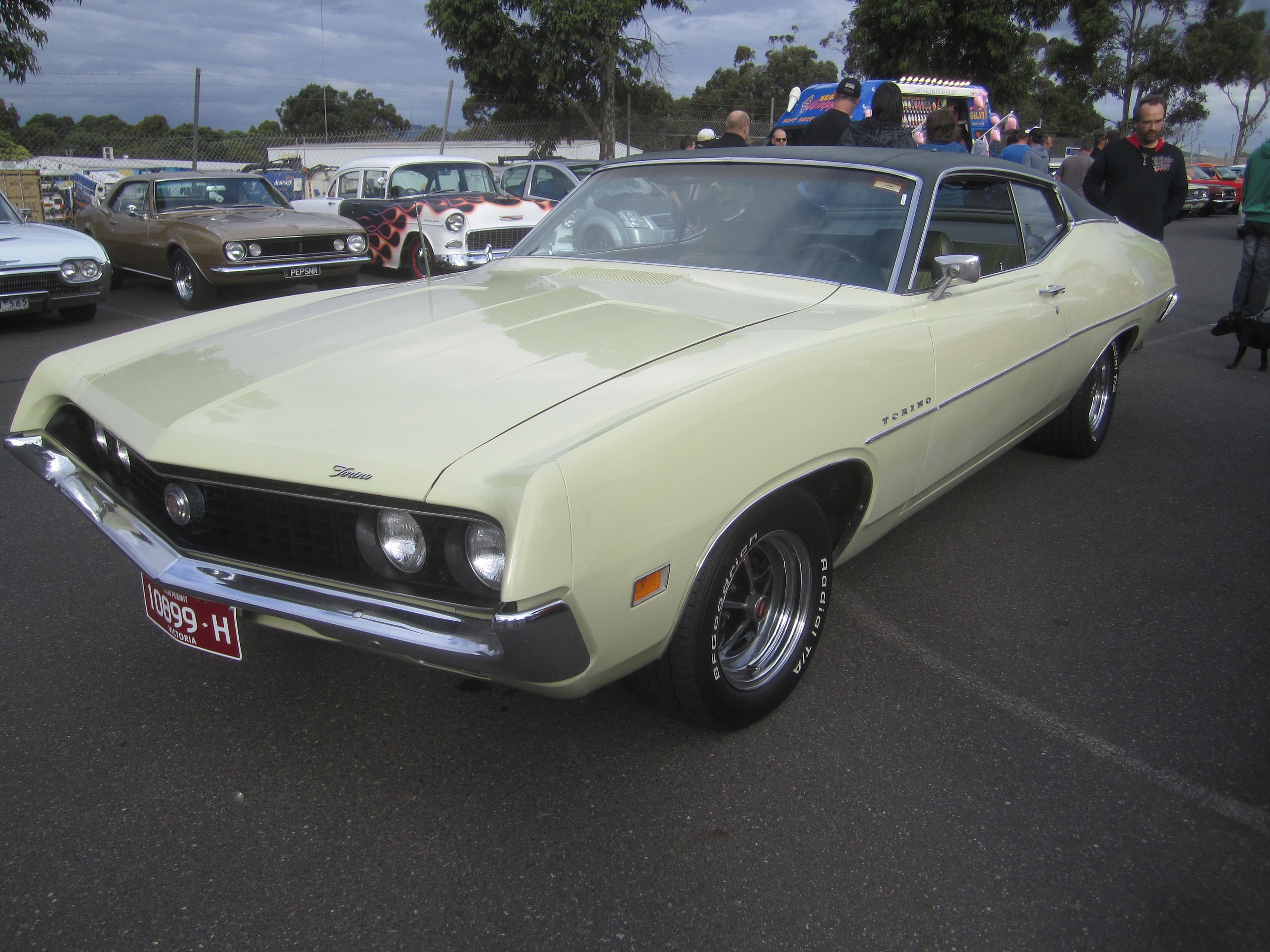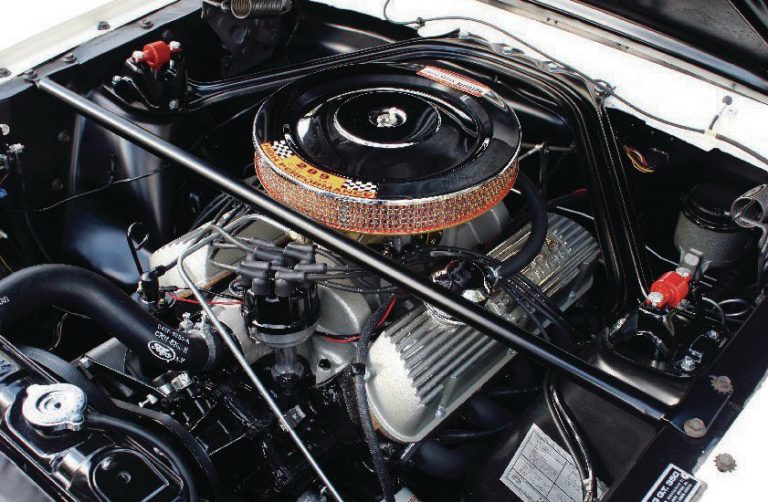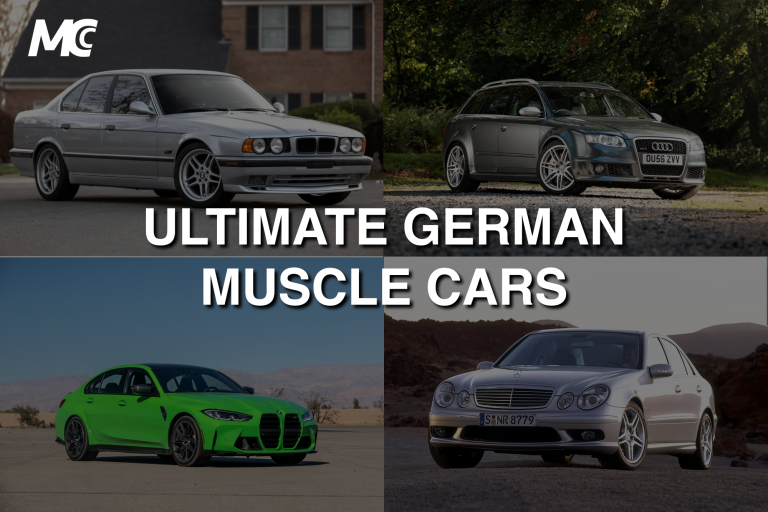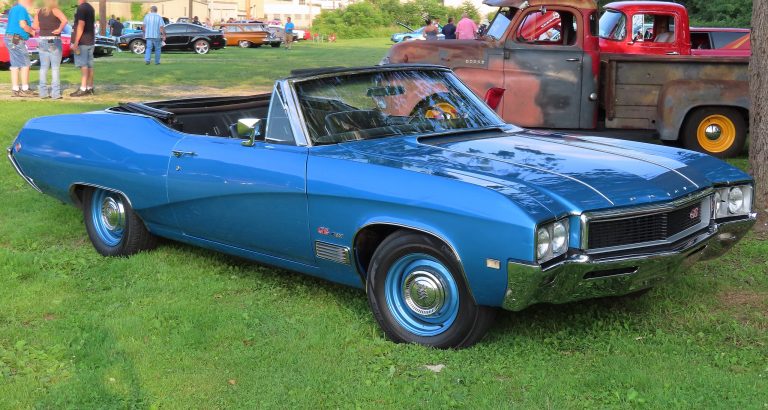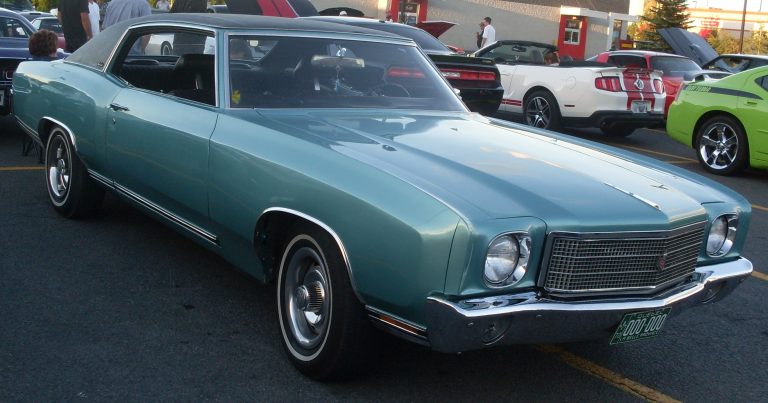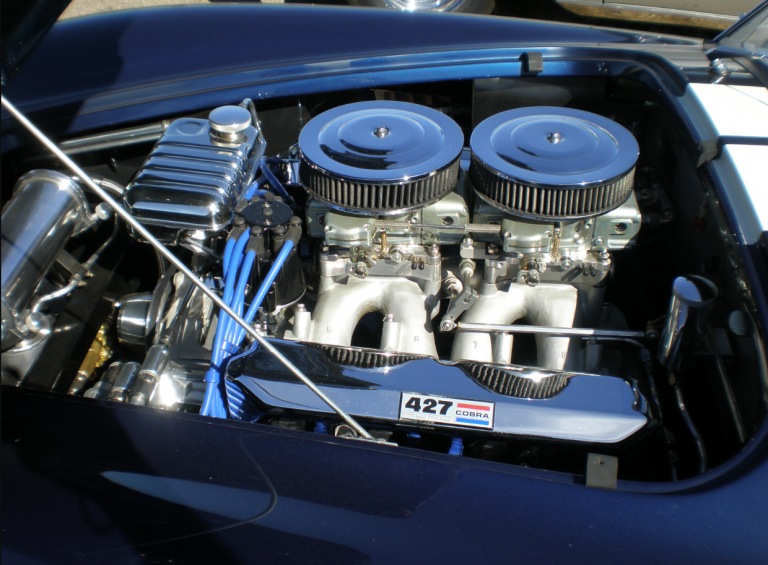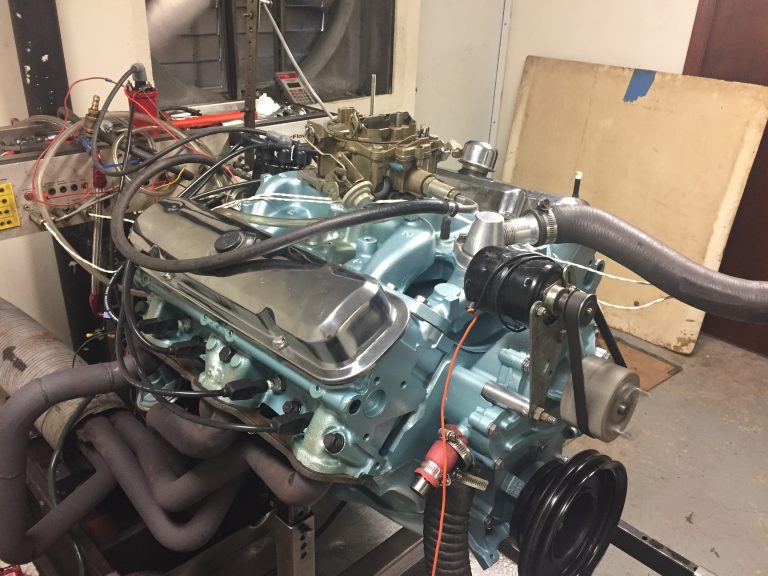Ford Torino and Ford Fairlane

Meet Chandler
Chandler has a bachelors and masters degree in history as well as a passion for classics and muscle cars. His education and historical knowledge makes him skilled at crafting highly detailed articles about America’s muscle cars and automotive history. His love of muscle cars is undeniable, with him seeking them out at every opportunity during his visits to auto shows and car meets. Chandler’s knowledge and enthusiasm towards automotive history make him a great asset to the Muscle Car Club community.
The Ford Torino was one of the top muscle cars on the market in the late-1960s through 1970s. Ford produced the Torino from 1968–1971, where it regularly sold among their top performers. They based the Torino on the Ford Fairlane, which they had introduced back in 1955. The Fairlane was one of Ford’s most powerful vehicles in the 1950s, getting the coveted big-block engines like the 390 and 427 V8s in the early ‘60s. When the 1968 Torino came out, Ford jammed in the same massive big-blocks, until soon upgrading to the even more powerful 428 and 429 Cobra Jets the next year. Read on to find out all about both the Ford Fairlane and Ford Torino.
Ford Fairlane and Ford Torino Overview
Ford produced the Ford Fairlane for seven generations from 1955–1970. It originally started out life as a full-size sedan, station wagon, two-door hardtop, or convertible, but moved to a intermediate/mid-size chassis from 1962-on. The Fairlaine regularly sold extremely well for Ford, and was one of the earliest vehicles to get serious performance. From its inaugural year in 1955, customers could order the Fairlane with powerful V8 engines.
By the early-1960s they were getting big-blocks, and Ford was also using them in stock car racing. The Fairlane remained popular throughout the 1960s, though Ford stopped putting them on the American market after 1970. They still continued to be available on the Australian market, but no longer appeared stateside. Still, the 1960s produced some of the best looking and fastest Fairlanes ever, and they are hot items on the collectors market.
In 1968, Ford introduced the Fairlane Torino, which was an upscaled version of the standard Fairlane. Both models used incredibly powerful big-block V8s, but the Torinos were the higher trim of the two. Ford named the Torino after Turin, Italy. Like the Fairlane, Ford also used the Torino in motorsports, and it was successful in NASCAR.
The Torino lasted for three generations until 1976, after which Ford retired the moniker. By then, the Torino was no longer very powerful due to emissions restrictions, though sales were still pretty good.
Ford initially thought about reviving the Fairlane name in America in 2005, but the new design ended up becoming the Ford Flex. In addition, many younger viewers were introduced to the Torino through the 2008 Clint Eastwood film “Gran Torino,” which featured a 1972 Gran Torino as the hero car.
1955-1961 Ford Fairlane
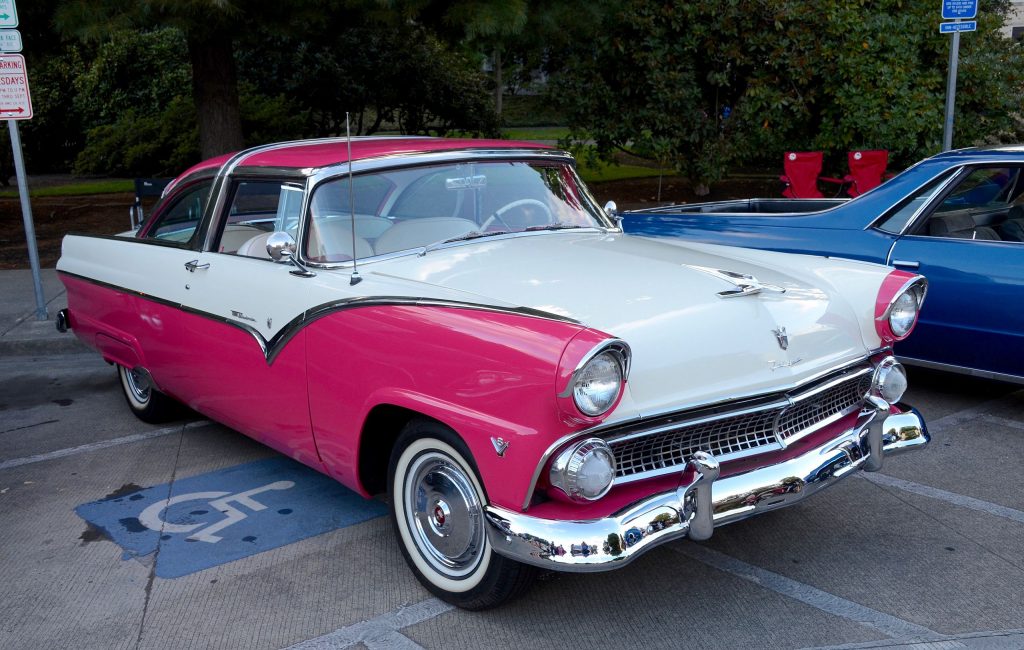
The first three generations of the Ford Fairlane lasted from 1955–1961. The first generation lasted from 1955–1956, and Ford introduced the Fairlane as the replacement for the Ford Crestline. The Fairlane had a backlit speedometer, tailfins, rounded headlights and parking lights that stuck out, and the Fairlane script written on the hood. There was also a stripe from the front fenders all the way to the rear of the car, and there were chrome eyebrows for the headlights.
The Fairlane came in six trims: Town Sedan, Club Sedan, Victoria, Crown Victoria, Crown Victoria Sky, and the Sunliner convertible. The name Fairlane came from the name of Henry Ford’s residence down the street from the factory in Dearborn.
Ford launched the second generation from 1957–1959, making it longer and wider and reducing the tailfins. For the 1957 Ford Fairlane, they added the Fairlane 500, which was the top trim option. The Fairlane 500 Skyliner had a power convertible top, but it was constantly prone to problems and was more expensive than the true convertible Sunliner.
For the 1958 Fairlane, Ford gave the lineup a facelift, which included dual headlights on each side, a Thunderbird style grille and bumper, and a scalloped rear deck. In 1959, Ford replaced the Fairlane with the Galaxie as the top option. They also gave the 1959 Fairlane a facelift with a new windshield, gullwing headlight covers, and a V back panel.
In 1960, Ford completely redesigned their entire lineup, including the Fairlane. The new Fairlane was longer, lower, still had a chrome strip along the side, the Fairlane script on the fenders, and Ford on the hood. For the 1961 Fairlane, Ford updated the bottom-half of the Fairlane, using a smaller canted fin, new chrome strip, and more.
1955-1961 Ford Fairlane Technical Specifications
| Model Years | Engine | Horsepower | Torque |
| 1955 | 223 cid I6 (1bbl) | 120 horsepower | 195 lb-ft |
| 1955 | 272 cid V8 (2bbl) | 162 horsepower | 258 lb-ft |
| 1955 | 272 cid V8 (4bbl) Power Pack | 182 horsepower | 261 lb-ft |
| 1956 | 223 cid I6 (1bbl) | 137 horsepower | 202 lb-ft |
| 1956 | 272 cid V8 (2bbl) | 173 horsepower | 260 lb-ft |
| 1956 | 292 cid V8 (4bbl) | 200 horsepower | 285 lb-ft |
| 1956 | 312 cid V8 (4bbl) | 225 horsepower | 324 lb-ft |
| 1957-1960 | 223 cid I6 (1bbl) | 144 horsepower | 212 lb-ft |
| 1957 | 272 cid V8 (2bbl) | 190 horsepower | 270 lb-ft |
| 1957 | 292 cid V8 (4bbl) | 212 horsepower | 297 lb-ft |
| 1957 | 312 cid V8 (4bbl) | 245 horsepower | 332 lb-ft |
| 1957 | 312 cid V8 (4bbl) | 270 horsepower | 336 lb-ft |
| 1957 | 312 cid V8 (4bbl) Supercharged | 300 horsepower | 439 lb-ft |
| 1958 | 292 cid V8 (2bbl) | 205 horsepower | 295 lb-ft |
| 1958 | 332 cid V8 (4bbl) | 265 horsepower | 360 lb-ft |
| 1958-1960 | 352 cid V8 (4bbl) | 300 horsepower | 380 lb-ft |
| 1959 | 292 cid V8 (2bbl) | 200 horsepower | 285 lb-ft |
| 1959 | 332 cid V8 (4bbl) | 225 horsepower | 325 lb-ft |
| 1960 | 292 cid V8 (2bbl) | 185 horsepower | 292 lb-ft |
| 1960 | 352 cid V8 (2bbl) | 235 horsepower | 350 lb-ft |
| 1960 | 352 cid V8 (4bbl) | 360 horsepower | 380 lb-ft |
| 1961 | 223 cid I6 (1bbl) | 135 horsepower | 200 lb-ft |
| 1961 | 292 cid V8 (2bbl) | 175 horsepower | 279 lb-ft |
| 1961 | 352 cid V8 (2bbl) | 220 horsepower | 336 lb-ft |
| 1961 | 390 cid V8 (4bbl) | 300 horsepower | 427 lb-ft |
| 1961 | 390 cid V8 (4bbl) | 375 horsepower | 427 lb-ft |
| 1961 | 390 cid V8 (3x2bbl) | 401 horsepower | 430 lb-ft |
1955-1961 Ford Fairlane Engines and Performance
For the first year, the 1955 Fairlane was offered with either a 223 cid inline-6 or a small-block 272 cid V8. The V8 was from the Y-block family and made 162 horsepower standard. That could be boosted to 182 with the Ford Power Pack option. The Power Pack used a Holley quad-barrel carb instead of a double-barrel, for the extra power.
For the 1956 Fairlane, Ford made the 312 Thunderbird V8 an option, and in 1957 made the supercharged version available, but that is disputed by some. The standard V8 had a low 6.4:1 compression ratio with a Holley four-barrel in 1956. In the 1957 Ford Fairlane, the 312 jumped to 270 horsepower with a 9.7:1 compression ratio. The supercharged 312 had a McCulloch/Paxton supercharger, Holley quad-barrel, and a lower 8.5:1 compression ratio for boost.
For 1958, Ford introduced even larger 332 and 352 cid V8s, which soon upped performance even more. The 332 was the “Interceptor V8,” while the 352 was the “Interceptor Special V8.” The 332 V8 made 265 horsepower through a 9.5:1 compression ratio and Holley four-barrel. The Interceptor Special pumped out 300 horsepower with a high 10.2:1 compression and Holley four-barrel. In the 1960 Fairlane, the Interceptor Special jumped to 360 horsepower with a higher 10.6:1 compression ratio.
In 1961, Ford made the first big-block available in the Fairlane, the “Thunderbird 390 V8.” The 390 pumped out either 300, 375, or 401 horsepower depending on the carburetor and compression. The top dog was the 10.6:1 compression “Thunderbird Special 390,” which used a tri-carb setup with three Holley double-barrels to make 401 horsepower.
1955-1961 Ford FairlaneProduction Number
| Model Year | Bodystyle | Production Total |
| 1955 | Fairlane All | 626,250 |
| 1956 | Fairlane All | 645,306 |
| 1957 | Fairlane All | 785,886 |
| 1958 | Fairlane All | 424,569 |
| 1959 | Fairlane All | 176,800 |
| 1960 | Fairlane All | 449,942 |
| 1961 | Fairlane All | 305,517 |
| 1955-1961 Total | Fairlane All | 3,414,270 |
1962-1970 Ford Fairlane
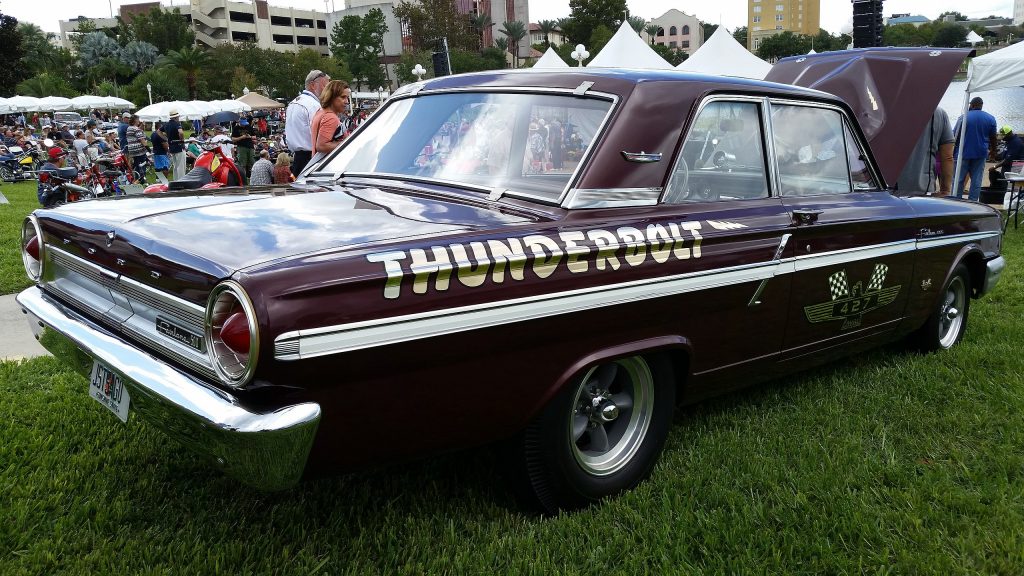
In 1962, Ford kicked off the fourth generation of the Fairlane by making it smaller. No longer a full-size, the Fairlane was almost a foot shorter and now could be considered an intermediate. This made them similar to the 1949–1950 Fords, but they sat lower. They had round tail lights, canted tail fins, and a Galaxie-inspired grille. The Fairlane could be had as either a four-door sedan or two-door sedan, and the Fairlane 500 series added a two-door sports coupe option.
For the 1963 Fairlane, Ford again restyled, removing sculpture lines from the sides, with the Fairlane model script on the trunk lid, and Ford on the hood like usual. In 1964, Ford gave the Fairlane new sheet metal for the body sides and rear, and smoother fear fenders.
In 1964, Ford also created the Fairlane Thunderbolt for use in NHRA stock racing. The Thunderbolt used a high-riser 427 cid engine with fiberglass fenders, hood blisters for the manifold, plexiglass windows, bucket seats, 8,000 rpm Rotunda tachometer, better suspension, a trunk mounted battery, and more to help with weight and aerodynamics.
In 1966, Ford introduced the GT and GTA special packages for the Fairlane. These packages included new badging on a new hood, body stripes, engine dress-up, better suspension, a sport steering wheel, and bigger engines. In 1968, Ford again redesigned the Fairlane, giving it a sportier fastback model and more curved sides. It resembled the similar Galaxie very much.
Ford last offered the Fairlane in 1970 in America, opting instead to continue the Torino line. The name still lasted in Australia for several more decades, but has never appeared stateside again.
1962-1970 Ford Fairlane Technical Specifications
| Model Years | Engine | Horsepower | Torque |
| 1962-1964 | 170 cid I6 (1bbl) | 101 horsepower | 156 lb-ft |
| 1962-1963 | 221 cid V8 (2bbl) | 145 horsepower | 216 lb-ft |
| 1963-1964 | 260 cid V8 (2bbl) | 164 horsepower | 258 lb-ft |
| 1964 | 292 cid V8 (2bbl) | 195 horsepower | 282 lb-ft |
| 1964-1967 | 292 cid V8 (4bbl) K-Code | 271 horsepower | 312 lb-ft |
| 1964-1965 | 390 cid V8 (4bbl) | 300 horsepower | 427 lb-ft |
| 1964 | 427 cid V8 (4bbl) | 425 horsepower | 480 lb-ft |
| 1965-1966 | 170 cid I6 (1bbl) | 105 horsepower | 160 lb-ft |
| 1965-1967 | 200 cid I6 (1bbl) | 120 horsepower | 190 lb-ft |
| 1965-1967 | 292 cid V8 (2bbl) | 200 horsepower | 282 lb-ft |
| 1966-1968 | 390 cid V8 (2bbl) | 275 horsepower | 400 lb-ft |
| 1966-1967 | 390 cid V8 (4bbl) | 335 horsepower | 427 lb-ft |
| 1966-1967 | 427 cid V8 (2x4bbl) | 425 horsepower | 480 lb-ft |
| 1968-1969 | 170 cid I6 (1bbl) | 100 horsepower | 155 lb-ft |
| 1968-1969 | 200 cid I6 (1bbl) | 115 horsepower | 190 lb-ft |
| 1968 | 292 cid V8 (2bbl) | 195 horsepower | 282 lb-ft |
| 1968 | 302 cid V8 (2bbl) | 210 horsepower | 295 lb-ft |
| 1968 | 390 cid V8 (4bbl) | 325 horsepower | 427 lb-ft |
| 1968 | 427 cid V8 (4bbl) | 390 horsepower | 460 lb-ft |
| 1968-1969 | 428 cid V8 (4bbl) Cobra Jet | 335 horsepower | 440 lb-ft |
| 1968-1969 | 428 cid V8 (4bbl) Super Cobra Jet | 360 horsepower | 440 lb-ft |
| 1969-1970 | 250 cid I6 (1bbl) | 155 horsepower | 240 lb-ft |
| 1969-1970 | 302 cid V8 (2bbl) | 220 horsepower | 300 lb-ft |
| 1969-1970 | 351 cid V8 (2bbl) | 250 horsepower | 355 lb-ft |
| 1969-1970 | 351 cid V8 (4bbl) | 290 horsepower | 380 lb-ft |
| 1970 | 250 cid (1bbl) | 155 horsepower | 240 lb-ft |
| 1970 | 429 cid V8 (4bbl) | 360 horsepower | 480 lb-ft |
| 1970 | 429 cid V8 (4bbl) | 370 horsepower | 450 lb-ft |
1962-1970 Ford Fairlane Engines and Performance
At first, Ford carried over the same engines from the previous generations, but things got serious in 1964 with the use of the high-riser 427 cid V8. Though it was rated at 425 horsepower, in reality it pushed out closer to 500 horsepower through several internal modifications. This was for use in the Thunderbolt, which ran a ¼ mile in 11.6 seconds at an incredible 124 mph.
In 1966–1967, Ford made the 427 available in production Fairlanes, but these were the famous “side-oiler” 427s and were slightly different. Customers could get either a quad-barrel carb or dual quad-barrel setup, which made either 410 or 425 horsepower. You had to buy the upscale Fairlane 500, but boy was it worth it. These 427 powered Fairlanes also had upgraded suspension and brakes to handle the power.
In 1968, the 302 V8 became an option for the first time. It made just 210 horsepower, and was dwarfed by the 325 horsepower 390 V8 and the slightly detuned 390 horsepower 427. The 302 used a Motorcraft double-barrel and had a 9.0:1 compression. There was a quad-barrel, 10.0:1 compression version that made 230 horsepower, but it did not make it inside the Fairlane.
Also for the 1968 Fairlane, Ford made the 428 Cobra Jet and Super Cobra Jets an option. The Cobra Jet 428 made 335 horsepower with a 10.7:1 compression and Holley four-barrel. The Super Cobra Jet 428 made 360 horsepower with a 10.5:1 compression and a larger Holley four-barrel.
The 351 and 429 Thunder Jet
For 1969–1970, Ford introduced the 351 and 429 V8s for high performance. The Cleveland 351 came as either a 9.5:1 compression, Motorcraft two-barrel at 250 horsepower, or with 290 horsepower, 10.7:1 compression and a Motorcraft quad-barrel.
However, the top dog was the 429 “Thunder-Jet V8” that made either 360 horsepower or 370 horsepower. Both used Holley four-barrels, and the 360 horsepower version had 10.5:1 compression, while the 370 horsepower jumped to 11.3:1 compression.
1962-1970 Ford Fairlane Production Numbers
| Model Year | Bodystyle | Production Total |
| 1962 | Fairlane All | 297,116 |
| 1963 | Fairlane All | 223,816 |
| 1964 | Fairlane All | 277,616 |
| 1965 | Fairlane All | 223,954 |
| 1966 | Fairlane All | 251,430 |
| 1967 | Fairlane All | 238,688 |
| 1968 | Fairlane All | 199,704 |
| 1969 | Fairlane All | 237,857 |
| 1970 | Fairlane All | 177,091 |
| 1962-1970 | Fairlane All | 2,127,272 |
1968-1971 Ford Torino
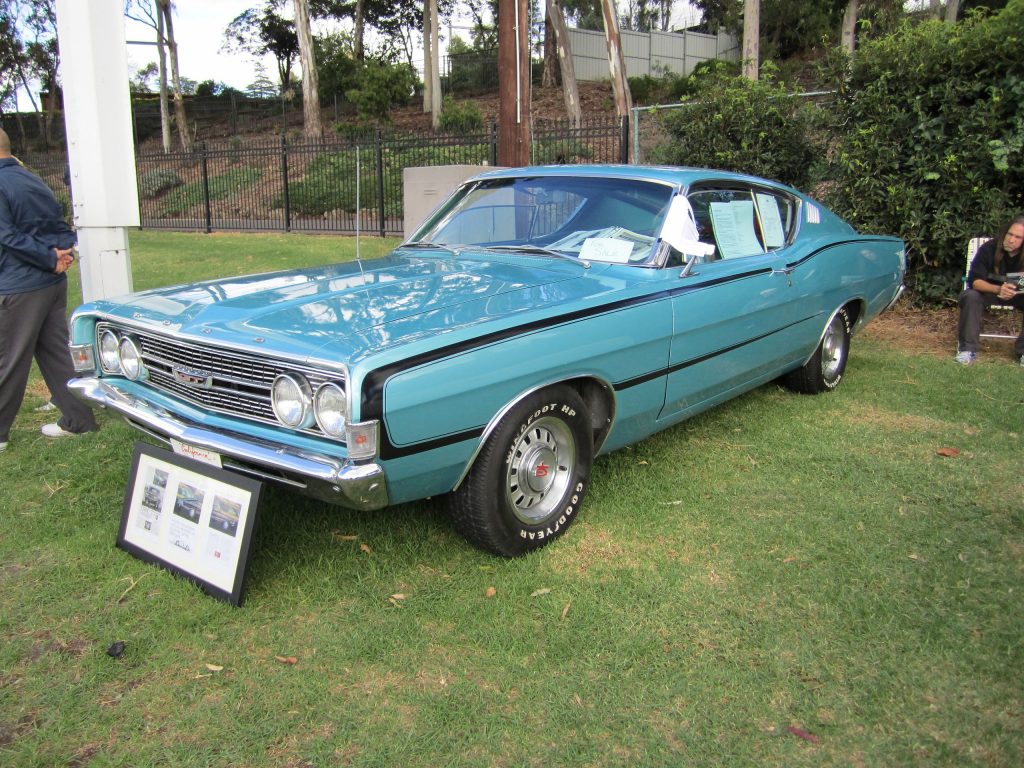
In 1968, Ford first introduced the Torino as the new high-trim option for the Fairlane. It moved the Fairlane 500 to the middle tier, and included everything the 500 had plus more. Customers could buy the Torino as a four-door sedan, two-door hardtop, or four-door station wagon. Even better was the Fairlane Torino GT, which came standard with the 302 V8. The GT had everything the standard Torino had, but a V8 engine and even more deluxe interior styling. The first generation lasted through 1969, and the second generation through 1971.
The next year, Ford brought out the 1969 Torino Cobra, which was an even more high performance version of the sporty Torino GT. The Cobra used the 428 big-block engine as standard, and was a direct competitor for the Plymouth RoadRunner. It had heavier duty suspension, bucket seats, and a huge cobra decal on the front fenders. There was also the rare Torino Talladega, which was longer and lower than the Torino.
For the 1970 Torino, Ford added the Brougham trim as the top option. It had new exterior moldings and retractable headlights. The Torino GT got a hood scoop, GT emblems, white sidewall tires, and trim rings with hubcaps. The Cobra got competition suspension, a black center hood, hood pins, Cobra emblems, black sidewall tires with raised white letters, and a functional hood scoop and rear louvers on the windows. All three models continued through 1971 looking relatively the same.
1968-1971 Ford Torino Technical Specifications
| Model Years | Engine | Horsepower | Torque |
| 1968 | 200 cid I6 (1bbl) | 115 horsepower | 190 lb-ft |
| 1968 | 302 cid V8 (2bbl) | 210 horsepower | 295 lb-ft |
| 1968 | 390 cid V8 (2bbl) | 265 horsepower | 390 lb-ft |
| 1968 | 390 cid V8 (4bbl) | 325 horsepower | 427 lb-ft |
| 1968 | 427 cid V8 (4bbl) | 390 horsepower | 460 lb-ft |
| 1968-1969 | 428 cid V8 (4bbl) Cobra Jet | 335 horsepower | 440 lb-ft |
| 1968-1969 | 428 cid V8 (4bbl) Super Cobra Jet | 360 horsepower | 440 lb-ft |
| 1969-1970 | 250 cid I6 (1bbl) | 155 horsepower | 240 lb-ft |
| 1969-1970 | 302 cid V8 (2bbl) | 220 horsepower | 300 lb-ft |
| 1969-1970 | 351 cid V8 (2bbl) | 250 horsepower | 355 lb-ft |
| 1969 | 351 cid V8 (4bbl) | 290 horsepower | 380 lb-ft |
| 1969 | 390 cid V8 (4bbl) | 320 horsepower | 427 lb-ft |
| 1970 | 351 cid V8 (4bbl) | 300 horsepower | 380 lb-ft |
| 1970-1971 | 429 cid V8 (4bbl) | 360 horsepower | 480 lb-ft |
| 1970-1971 | 429 cid V8 (4bbl) | 370 horsepower | 450 lb-ft |
| 1971 | 250 cid I6 (1bbl) | 145 horsepower | 240 lb-ft |
| 1971 | 302 cid V8 (2bbl) | 210 horsepower | 300 lb-ft |
| 1971 | 351 cid V8 (2bbl) | 240 horsepower | 355 lb-ft |
| 1971 | 351 cid V8 (4bbl) | 285 horsepower | 380 lb-ft |
1968-1971 Ford Torino Engines and Performance
The Torino offered the same engines as the Fairlane, and the Torino also got the six-cylinder engines, too. Like the Fairlane, the highest profile engines were the 427 V8 and 428 and 429 Cobra Jets, as well as the 390 big-block and 351 Cleveland V8s.
The Torino was one of the few Ford gave the 429 V8 to in 1971, as emissions were already beginning to take their toll on their big-block lineup. In 1971, Ford dropped the 428 Cobra Jets for that reason, keeping only the 429 and 351 V8s as the high performance options.
1968-1971 Ford Torino Production Numbers
| Model Year | Bodystyle | Production Total |
| 1968 | Torino | 68,699 |
| Torino GT | 103,384 | |
| 1968 Total | 172,083 | |
| 1969 | Torino | 47,232 |
| Torino GT/Cobra | 81,822 | |
| 1969 Total | 129,054 | |
| 1970 | Torino | 117,358 |
| Torino GT | 60,758 | |
| Torino Cobra | 7,675 | |
| Torino Brougham | 44,620 | |
| 1970 Total | 178,116 | |
| 1971 | Torino/Torino 500 | 261,349 |
| Torino Brougham/GT/Cobra | 65,114 | |
| 1971 Total | 326,463 |
1972-1976 Ford Torino

Ford produced the third and final generation of the Torino from 1972–1976. This was the first generation that the Torino stood completely on its own, as the Fairlane line was dropped after 1970. Ford completely redesigned the Torino for 1972, also adding the new Gran Torino as the top trim option. They had a more pronounced coke bottle shape, chrome windshield and rear window and rain gutter moldings, high back bench seats, floor mats, trim rings on hubcaps, and a station wagon with a three-way tailgate. The Gran Torino got a deluxe interior and wood covers.
There was also the Gran Torino Sport, which was the sporty version of the Gran Torino. The 1973 Torinos got a new grille and larger front bumper, which Ford again revised for the 1974 Torino. There was also the new Gran Torino Elite series introduced midyear, which had deluxe exterior options. Another model was the Gran Torino Squire wagon.
For the final 1976 Torino, there were 9 different model options, including two and four-door options and three different wagons. The Gran Torino Sport no longer appeared, and the four-door wheelbase was 4 inches longer than the two-door. Ford dropped the Torino after 1976. Sales had slumped, though were still around 200,000, but Ford chose to focus on other vehicles like the Maverick and LTD, among others.
Today, the Torino, GT, and Gran Torinos are very fondly remembered by muscle car enthusiasts. Due to their high production total, they are also usually available on the collectors market for a decent price.
1972-1976 Ford Torino Technical Specifications
| Model Years | Engine | Horsepower | Torque |
| 1972 | 250 cid I6 (1bbl) | 98 horsepower | 180 lb-ft |
| 1972 | 302 cid V8 (2bbl) | 140 horsepower | 230 lb-ft |
| 1972 | 351 cid V8 (2bbl) | 153 horsepower | 270 lb-ft |
| 1972-1973 | 351 cid V8 (4bbl) | 248 horsepower | 299 lb-ft |
| 1972 | 400 cid V8 (2bbl) | 172 horsepower | 296 lb-ft |
| 1972 | 429 cid V8 (4bbl) | 212 horsepower | 320 lb-ft |
| 1973-1974 | 250 cid I6 (1bbl) | 88 horsepower | 180 lb-ft |
| 1973 | 302 cid V8 (2bbl) | 135 horsepower | 230 lb-ft |
| 1973 | 351 cid V8 (2bbl) | 156 horsepower | 250 lb-ft |
| 1973 | 400 cid V8 (2bbl) | 168 horsepower | 310 lb-ft |
| 1973 | 429 cid V8 (4bbl) | 197 horsepower | 320 lb-ft |
| 1974 | 302 cid V8 (2bbl) | 140 horsepower | 230 lb-ft |
| 1974 | 351 cid V8 (2bbl) | 162 horsepower | 278 lb-ft |
| 1974 | 351 cid V8 (4bbl) | 255 horsepower | 290 lb-ft |
| 1974 | 400 cid V8 (2bbl) | 170 horsepower | 330 lb-ft |
| 1974 | 460 cid V8 (4bbl) | 215 horsepower | 350 lb-ft |
| 1975 | 302 cid V8 (2bbl) | 129 horsepower | 230 lb-ft |
| 1975 | 351 cid V8 (2bbl) | 148 horsepower | 245 lb-ft |
| 1975 | 400 cid V8 (2bbl) | 158 horsepower | 265 lb-ft |
| 1975 | 460 cid V8 (4bbl) | 218 horsepower | 365 lb-ft |
| 1976 | 351 cid V8 (2bbl) | 152 horsepower | 274 lb-ft |
| 1976 | 400 cid V8 (2bbl) | 180 horsepower | 336 lb-ft |
| 1976 | 460 cid V8 (4bbl) | 202 horsepower | 352 lb-ft |
1972-1976 Ford Torino Engines and Performance
Unfortunately for the Torino, after 1971 performance declined severely. This was largely due to emissions restrictions, which were made tougher to fight against climate change. This resulted in lower compression and detuned motors for several decades until the 1990s. In addition, from 1972-on Ford began stating horsepower numbers according to SAE Net ratings rather than SAE Gross. Net ratings are almost universally lower than Gross ratings, making the cars seem even less powerful than they were.
For the 1972 Torino, the highest output engine was the 248 horsepower 351 Cleveland V8. It used a Holley four-barrel and had a 8.6:1 compression ratio. The 429 V8 was also available, but only at 212 horsepower. New was a 400 cid Cleveland V8 that made 172 horsepower with a Motorcraft two-barrel and 8.5:1 compression.
The only other new engine the Torino would see would be a 460 cid “Thunderbird V8.” This made 215 horsepower inside the Torino through a Carter four-barrel carb and 8.0:1 compression. By the 1976 Torino, this had dropped down to 202 horsepower, which was still good for top dog among Torinos.
1972-1976 Ford Torino Production Numbers
| Model Year | Bodystyle | Production Total |
| 1972 | Torino & Gran Torino | 496,645 |
| 1973 | Torino All | 496,581 |
| 1974 | Torino All | 426,086 |
| 1975 | Torino All | 318,482 |
| 1976 | Torino All | 193,096 |
| 1972-1976 | Torino All | 1,930,890 |
Ford Fairlane and Torino FAQ
Comparatively, the Ford Torino was one of the higher production Ford cars in the 1960s and 1970s. In total, Ford produced more than 2 million Torinos during its run from 1968–1976.
Yes. Many people consider the Torino to be a muscle car. It was available as a two-door coupe, had big-block V8 engines, many different options, and produced incredible performance.
The Gran Torino was the highest trim version of the Torino. It had a deluxe interior and exterior, as well as a high performance V8 engine. There was also the Gran Torino Sport, which was the high performance version of the Gran Torino.
Many people consider the Ford Fairlane to be an early muscle car. It utilized big-block V8 engines and could be had as a two-door with a variety of options. The true muscle car, however, was the Fairlane Torino, which looked even more the part.
Ford produced the Fairlane from 1955–1970. They also produced the Fairlane Torino from 1968–1970, after which the Torino became a stand alone model through 1976.

